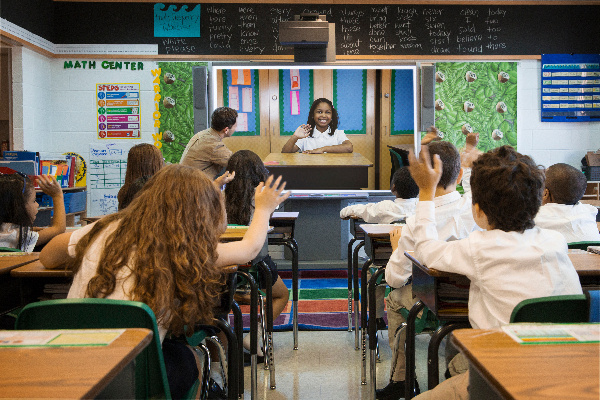Published on
Building a Future of Skills: How Microcredentials Are Shaping Education

Microcredentials are transforming education by bridging K-12 and higher education, equipping students with relevant skills for a rapidly evolving workforce. As institutions adopt these credentials, they create lifelong learning pathways that align with industry needs and enhance student engagement and employability. In this interview, Zach Dane discusses the current state of microcredentials in the K-12 space, the challenges schools face and how to set up learners early for a lifetime of learning.
The EvoLLLution (Evo): How do you view the current microcredential landscape, and what trends are shaping their adoption?
Zach Dane (ZD): Within K-12 education, there’s a lot of room to grow with microcredentials and digital badges. So much energy is focused on higher ed and lacking on the K-12 side of things. My doctoral dissertation was on K-12, but now my work is focused on engaging students in this microcredential process to prepare them for the higher ed space.
Amazing things have happened in the past ten years, as microcredentials have been able to provide a comparable and supplemental experience to the traditional degree. It’s exciting to see where we can go with microcredentials and digital badges.
The current higher ed landscape is in a good spot, ahead of the game, especially compared to K-12. But there’s a lot of innovation and transformation to come. We can then take knowledge from the higher ed landscape and leverage it for the K-12 space.
Evo: What are some key challenges to creating a lifelong learning culture?
ZD: The biggest challenge is the perception of microcredentials’ value. When someone becomes certified as an educator for a company it makes them an expert in that tool as a teacher. But the challenge is providing excitement around the value and experience they’ve gained. The more value an organization puts into it, the more the recipient gets out of it.
Once they have that value, we have to look at how we as a culture and society enable employers to provide that experience and opportunity. How do the credentials a learner earns translate into value for an employer? It can’t just be a shiny little badge. It has to have benefits in the future.
Evo: What strategies would you recommend to effectively integrate microcredentials into an institution’s broader academic offerings?
ZD: There is much more research in higher ed than in the K-12 space. The best strategy would be to build upon what already exists in the K-12 space. We have continuing and technical education (CTE), and we can leverage our partnerships with CTE organizations and third-party vendors to make credentials more meaningful and expand them for our students.
The internet was once somewhere we accessed information, now look at it. It would not be possible without those foundations. And having the building blocks and a big-picture mindset can really propel us forward into the innovation and transformation we need.
Evo: What role do microcredentials play in addressing workforce development needs, and how can institutions ensure they align with industry demands?
ZD: There are so many great opportunities for students to go directly into the workforce and do amazing things. Some schools in our systems provide credentials to students in technical certifications and get them licensed while they’re in high school. So, when they graduate with their high school diploma, they also have these other industry certifications. They can leave high school, immediately get a full-time job and be a contributing member to society, or they can go into the higher ed space and learn and engage more.
Microcredentials provide an invaluable alternative and supplement to traditional education. They provide opportunities for learners to showcase their knowledge, benefit from what they’ve earned and translate that information into the larger community.
Evo: How do you envision technology playing that role in the future of microcredentials?
ZD: Asynchronous learning is the first thing that comes to mind. There are so many things that fall to a time clock. Technology can provide that asynchronous learning space. If someone wants to learn something their school doesn’t offer, then the learner can go engage in that learning on their own time.
I used to teach at a small school of 500 students. We had students who wanted to get an advanced certification or diploma and learn an additional language beyond Spanish, which the school provided. So, we connected them to another remote teacher who was able to provide that experience for them.
Technology is invaluable because you can engage with learning at your own time through all the available video resources. You can connect to learners, and create new videos and new learning management systems to provide an optimal learning experience for students.
Evo: What are the opportunities for innovation in this space?
ZD: I will reference the movie Mean Girls here and say that the limit does not exist. There isn’t a limit to what we do, especially with the power and influence of 1EdTech, which works with K-12, higher ed and industry partners. Through these collaborations, they’re able to provide credentials and make them more valuable.
Once there’s more communication and collaboration among these three different entities, the big-picture energy will come together, and we’ll be able to have an entirely new credentialing space.
Evo: Is there anything you’d like to add?
ZD: I highly recommend anyone come to the 1EdTech Digital Credentials Summit in March. It’s great to get various education leaders together to talk about how to improve the perceived efficacy for educators and credential recipients. Also, continue to innovate and try something new. The worst that can happen if you try something and it doesn’t work is that you learn from it and try again.




